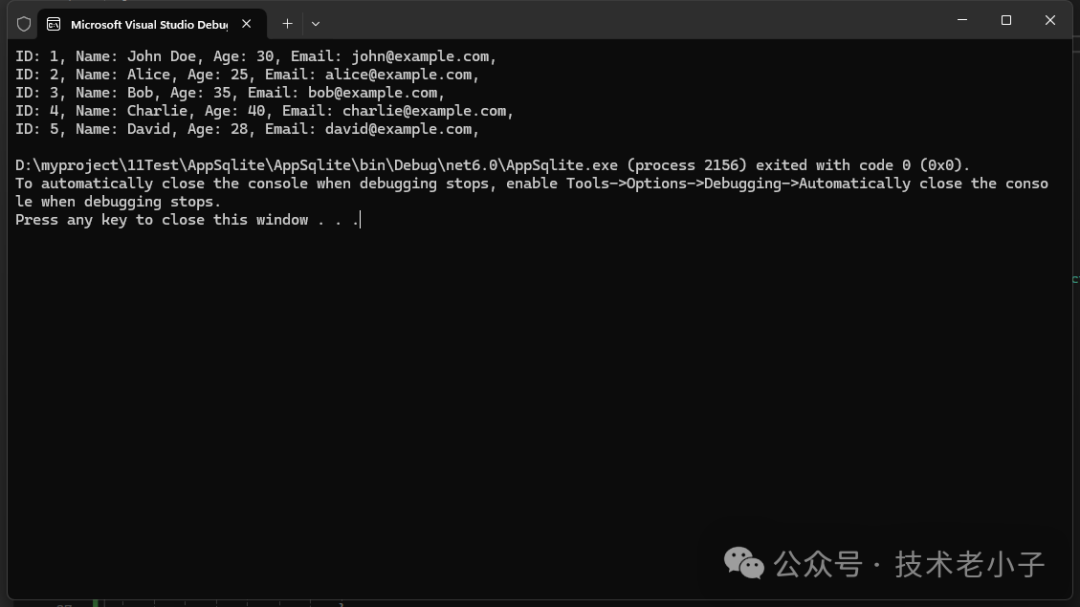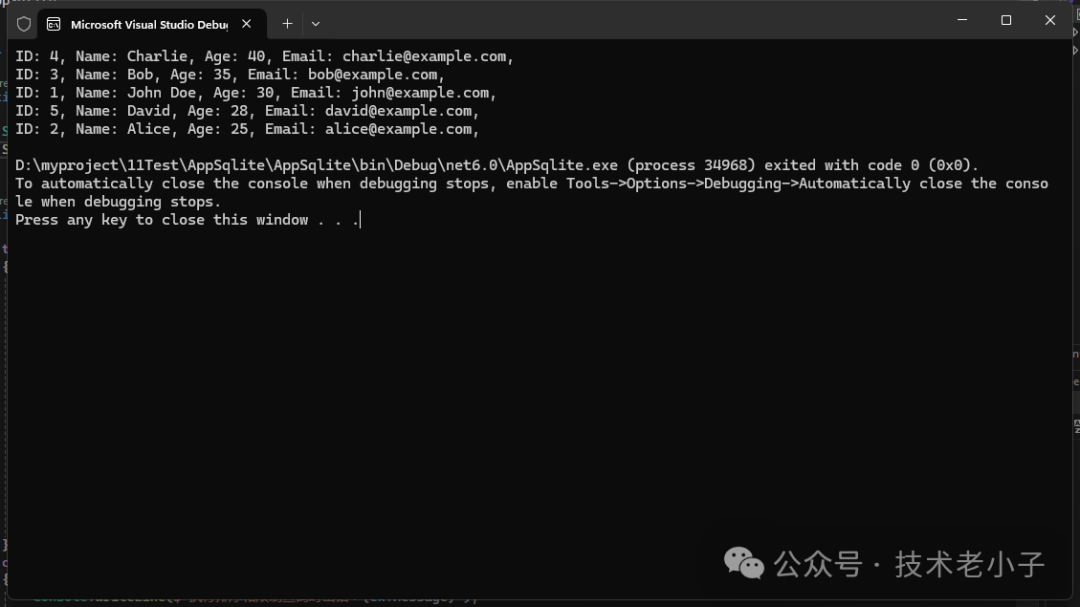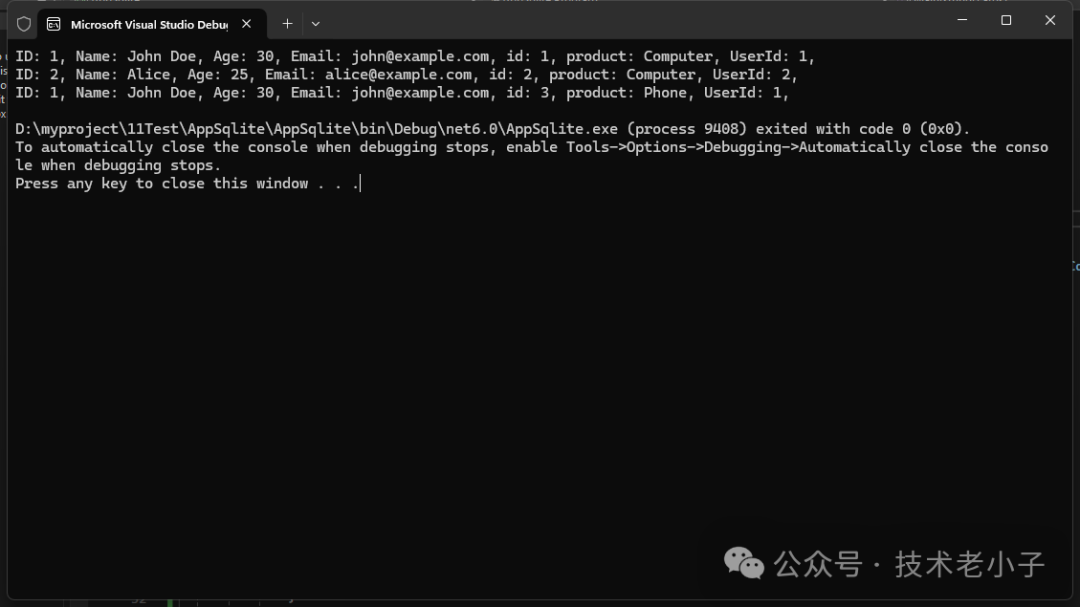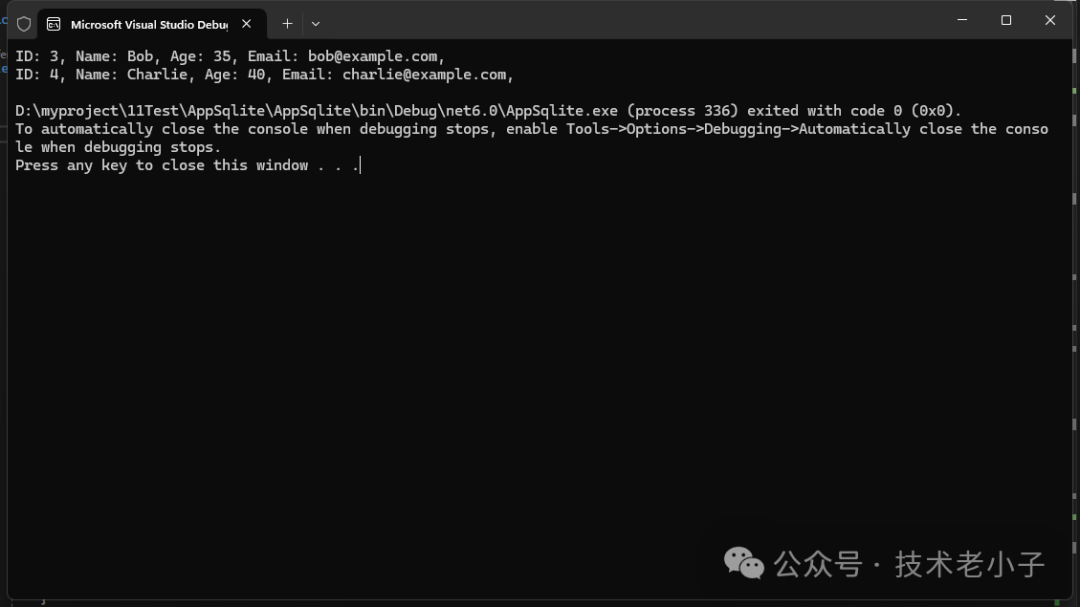本文将详细介绍如何使用 C# 在 SQLite 数据库中执行 SELECT 操作。SELECT 操作是数据库查询中最常用和最重要的操作,用于从数据库中检索数据。
准备工作
首先,确保你的项目中已安装 System.Data.SQLite NuGet 包。在你的 C# 文件顶部添加以下 using 语句:
using System;using System.Data;using System.Data.SQLite;
连接到数据库
在执行任何查询之前,我们需要建立与数据库的连接。以下是一个建立连接的辅助方法:
public static SQLiteConnection ConnectToDatabase(string dbPath){ try { SQLiteConnection connection = new SQLiteConnection($"Data Source={dbPath};Version=3;"); connection.Open(); return connection; } catch (Exception ex) { Console.WriteLine($"连接数据库时出错:{ex.Message}"); return null; }}
基本的 SELECT 操作
查询所有记录
以下是一个查询表中所有记录的方法:
public static void SelectAllRecords(SQLiteConnection connection, string tableName){ try { string sql = $"SELECT * FROM {tableName}"; using (SQLiteCommand command = new SQLiteCommand(sql, connection)) { using (SQLiteDataReader reader = command.ExecuteReader()) { while (reader.Read()) { for (int i = 0; i < reader.FieldCount; i++) { Console.Write($"{reader.GetName(i)}: {reader[i]}, "); } Console.WriteLine(); } } } } catch (Exception ex) { Console.WriteLine($"查询所有记录时出错:{ex.Message}"); }}
使用示例:
SelectAllRecords(connection, "Users");

使用条件查询
以下是一个带条件的查询方法:
public static void SelectRecordsWithCondition(SQLiteConnection connection, string tableName, string condition){ try { string sql = $"SELECT * FROM {tableName} WHERE {condition}"; using (SQLiteCommand command = new SQLiteCommand(sql, connection)) { using (SQLiteDataReader reader = command.ExecuteReader()) { while (reader.Read()) { for (int i = 0; i < reader.FieldCount; i++) { Console.Write($"{reader.GetName(i)}: {reader[i]}, "); } Console.WriteLine(); } } } } catch (Exception ex) { Console.WriteLine($"条件查询记录时出错:{ex.Message}"); }}
使用示例:
SelectRecordsWithCondition(connection, "Users", "Age > 30");

使用参数化查询
为了防止 SQL 注入攻击并提高性能,我们应该使用参数化查询:
public static void SelectRecordsWithParameters(SQLiteConnection connection, string tableName, string condition, Dictionary<string, object> parameters){ try { string sql = $"SELECT * FROM {tableName} WHERE {condition}"; using (SQLiteCommand command = new SQLiteCommand(sql, connection)) { foreach (var param in parameters) { command.Parameters.AddWithValue(param.Key, param.Value); }
using (SQLiteDataReader reader = command.ExecuteReader()) { while (reader.Read()) { for (int i = 0; i < reader.FieldCount; i++) { Console.Write($"{reader.GetName(i)}: {reader[i]}, "); } Console.WriteLine(); } } } } catch (Exception ex) { Console.WriteLine($"参数化查询记录时出错:{ex.Message}"); }}
使用示例:
var parameters = new Dictionary<string, object>{ { "@minAge", 25 }, { "@maxAge", 40 }};SelectRecordsWithParameters(connection, "Users", "Age BETWEEN @minAge AND @maxAge", parameters);

高级 SELECT 操作
使用聚合函数
SQLite 支持多种聚合函数,如 COUNT, AVG, SUM 等。以下是一个使用聚合函数的示例:
public static void SelectWithAggregation(SQLiteConnection connection, string tableName, string aggregation){ try { string sql = $"SELECT {aggregation} FROM {tableName}"; using (SQLiteCommand command = new SQLiteCommand(sql, connection)) { object result = command.ExecuteScalar(); Console.WriteLine($"聚合结果:{result}"); } } catch (Exception ex) { Console.WriteLine($"执行聚合查询时出错:{ex.Message}"); }}
使用示例:
SelectWithAggregation(connection, "Users", "AVG(Age)");

使用 ORDER BY 和 LIMIT
以下是一个带排序和限制结果数量的查询方法:
public static void SelectWithOrderAndLimit(SQLiteConnection connection, string tableName, string orderBy, int limit){ try { string sql = $"SELECT * FROM {tableName} ORDER BY {orderBy} LIMIT {limit}"; using (SQLiteCommand command = new SQLiteCommand(sql, connection)) { using (SQLiteDataReader reader = command.ExecuteReader()) { while (reader.Read()) { for (int i = 0; i < reader.FieldCount; i++) { Console.Write($"{reader.GetName(i)}: {reader[i]}, "); } Console.WriteLine(); } } } } catch (Exception ex) { Console.WriteLine($"执行排序和限制查询时出错:{ex.Message}"); }}
使用示例:
SelectWithOrderAndLimit(connection, "Users", "Age DESC", 5);

使用 JOIN
以下是一个使用 JOIN 的示例方法:
public static void SelectWithJoin(SQLiteConnection connection, string table1, string table2, string joinCondition){ try { string sql = $"SELECT * FROM {table1} INNER JOIN {table2} ON {joinCondition}"; using (SQLiteCommand command = new SQLiteCommand(sql, connection)) { using (SQLiteDataReader reader = command.ExecuteReader()) { while (reader.Read()) { for (int i = 0; i < reader.FieldCount; i++) { Console.Write($"{reader.GetName(i)}: {reader[i]}, "); } Console.WriteLine(); } } } } catch (Exception ex) { Console.WriteLine($"执行 JOIN 查询时出错:{ex.Message}"); }}
使用示例:
SelectWithJoin(connection, "Users", "Orders", "Users.Id = Orders.UserId");

使用 DataTable 存储结果
对于需要在内存中处理查询结果的情况,我们可以使用 DataTable:
public static DataTable SelectToDataTable(SQLiteConnection connection, string sql){ try { DataTable dt = new DataTable(); using (SQLiteCommand command = new SQLiteCommand(sql, connection)) { using (SQLiteDataAdapter adapter = new SQLiteDataAdapter(command)) { adapter.Fill(dt); } } return dt; } catch (Exception ex) { Console.WriteLine($"查询到 DataTable 时出错:{ex.Message}"); return null; }}
使用示例:
DataTable dt = SelectToDataTable(connection, "SELECT * FROM Users WHERE Age > 30");foreach (DataRow row in dt.Rows){ foreach (DataColumn col in dt.Columns) { Console.Write($"{col.ColumnName}: {row[col]}, "); } Console.WriteLine();}

完整示例
以下是一个完整的示例,展示了如何使用上述所有方法:
using System;using System.Collections.Generic;using System.Data;using System.Data.SQLite;
class Program{ static void Main(string[] args) { string dbPath = "C:\\example.db"; SQLiteConnection connection = ConnectToDatabase(dbPath);
if (connection != null) { // 查询所有记录 Console.WriteLine("所有用户:"); SelectAllRecords(connection, "Users");
// 条件查询 Console.WriteLine("\n30岁以上的用户:"); SelectRecordsWithCondition(connection, "Users", "Age > 30");
// 参数化查询 Console.WriteLine("\n25到40岁的用户:"); var parameters = new Dictionary<string, object> { { "@minAge", 25 }, { "@maxAge", 40 } }; SelectRecordsWithParameters(connection, "Users", "Age BETWEEN @minAge AND @maxAge", parameters);
// 聚合查询 Console.WriteLine("\n用户平均年龄:"); SelectWithAggregation(connection, "Users", "AVG(Age)");
// 排序和限制结果 Console.WriteLine("\n年龄最大的5个用户:"); SelectWithOrderAndLimit(connection, "Users", "Age DESC", 5);
// JOIN 查询 Console.WriteLine("\n用户及其订单:"); SelectWithJoin(connection, "Users", "Orders", "Users.Id = Orders.UserId");
// 查询到 DataTable Console.WriteLine("\n30岁以上的用户(使用 DataTable):"); DataTable dt = SelectToDataTable(connection, "SELECT * FROM Users WHERE Age > 30"); foreach (DataRow row in dt.Rows) { foreach (DataColumn col in dt.Columns) { Console.Write($"{col.ColumnName}: {row[col]}, "); } Console.WriteLine(); }
// 关闭连接 connection.Close(); } }
// 在这里实现所有上述方法}
注意事项
始终使用参数化查询来防止 SQL 注入攻击。
对于大型结果集,考虑使用分页查询或流式处理来避免内存问题。
正确处理 NULL 值,特别是在使用聚合函数时。
在完成操作后,记得关闭数据库连接。
对于频繁执行的查询,可以考虑使用预处理语句(prepared statements)来提高性能。
结论
本文详细介绍了如何使用 C# 在 SQLite 数据库中执行各种 SELECT 操作,包括基本查询、条件查询、参数化查询、聚合查询、排序和限制结果、JOIN 操作以及使用 DataTable 存储结果。这些操作覆盖了大多数常见的数据检索场景。
该文章在 2024/10/22 12:24:35 编辑过